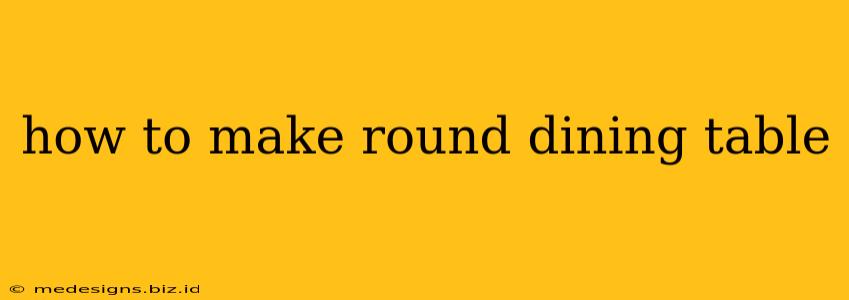Building your own round dining table is a rewarding project that can add a unique, personal touch to your home. This guide provides a comprehensive walkthrough, covering everything from material selection to finishing touches. Whether you're a seasoned DIY enthusiast or a beginner, you'll find this guide helpful in creating your perfect round dining table.
Choosing Your Materials: The Foundation of Your Table
The first step in making a round dining table is selecting the right materials. Your choices will impact the final look, durability, and overall cost.
1. The Tabletop:
- Wood: Hardwoods like oak, maple, and cherry offer superior durability and a beautiful grain. Softwoods like pine are more affordable but may require more care. Consider reclaimed wood for a unique, eco-friendly option. Think about the size and thickness you need for your desired table diameter. A thicker top will be more sturdy.
- Concrete: For a modern industrial look, concrete offers exceptional strength and a unique aesthetic. However, it's heavier and requires specialized skills and tools for pouring and finishing.
- Glass: Glass tabletops provide a sleek, contemporary look, but they're more susceptible to scratches and require careful handling.
2. The Base:
- Wood: Wooden bases can be crafted from various hardwoods, providing a cohesive look with a wooden tabletop. You can create a pedestal base, a trestle base, or even a simple four-legged design.
- Metal: Metal bases offer a modern feel and are exceptionally strong. Steel, iron, and even repurposed metal pipes are popular choices. They can be welded or bolted together.
- Combination: Combining wood and metal creates a unique blend of styles. For instance, a wooden tabletop paired with a metal base offers a striking contrast.
Designing Your Round Dining Table: Planning is Key
Before you start cutting wood, carefully plan your design. This includes determining:
1. Table Dimensions:
Measure your dining space to determine the ideal diameter of your tabletop. Consider how many people you want to comfortably seat at your table. A general rule of thumb is to allow 24-30 inches per person around the circumference.
2. Tabletop Thickness:
A thicker tabletop offers more stability and durability. Consider a thickness of at least 1.5 inches for a sturdy table.
3. Base Design:
Sketch out your desired base design. Consider the style of your home and the overall aesthetic you want to achieve. Will it be a simple pedestal base, a complex multi-legged design, or something in between?
Building Your Round Dining Table: A Step-by-Step Process
This section outlines the general steps. The specifics will vary depending on your chosen materials and design.
1. Preparing the Tabletop:
- Cut the wood: Use a circular saw or a router to cut your chosen wood to the desired diameter. For a perfectly round tabletop, use a router jig or a compass to guide your cuts.
- Sand the edges: Smooth the edges of the tabletop using sandpaper, starting with coarser grits and progressing to finer grits for a smooth finish.
2. Constructing the Base:
- Cut and assemble the base components: Follow your chosen design to cut and assemble the base pieces. Use woodworking glue, screws, and possibly welding equipment (depending on your materials).
- Ensure stability: Check the stability of the base before attaching it to the tabletop. The base should be sturdy and level.
3. Attaching the Tabletop:
- Securely attach the tabletop: Use screws, bolts, or even specialized table top fasteners to securely attach the tabletop to the base. Ensure the tabletop is centered and level.
4. Finishing Touches:
- Sanding and finishing: Sand the entire table, paying close attention to any rough areas or imperfections. Apply your chosen finish – paint, stain, varnish, or polyurethane – to protect the wood and enhance its beauty.
Essential Tools and Equipment: Gearing Up for Success
Building a round dining table requires specific tools. These may vary depending on your design, but generally include:
- Measuring tape and pencil
- Circular saw or router
- Sandpaper (various grits)
- Wood glue
- Screws or bolts
- Wood clamps
- Safety glasses and hearing protection
- Finishing materials (paint, stain, varnish, polyurethane)
Tips for Success: Achieving Professional Results
- Plan carefully: Accurate planning is crucial for a successful project. Measure twice, cut once!
- Use high-quality materials: Investing in good quality wood or metal will result in a more durable and attractive table.
- Take your time: Don't rush the process. Careful attention to detail will make a significant difference in the final product.
- Seek help if needed: If you're unsure about any aspect of the project, don't hesitate to seek help from experienced woodworkers or other DIY enthusiasts.
Building your own round dining table is a challenging but rewarding project. By following these steps and paying attention to detail, you can create a beautiful and functional piece of furniture that will be enjoyed for years to come. Remember to always prioritize safety and enjoy the process!
